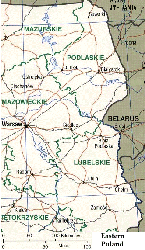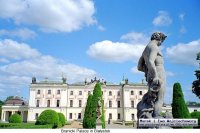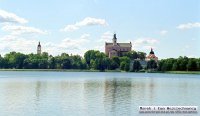 |
EAST POLAND TOUR Part 1 - Nature Preserves and Parks - Białystok |
Bill Biega's Travel Information |
|
Click on any illustration with colored border to see it full size. Then click on "Back" button to return to this page.
Eastern Poland - the Podlasie and Lubelskie districts - is predominantly flat and agricultural. However, here you find some of Europe's finest nature preserves and national parks. There are also a number of well preserved magnificent palaces. 
In summer time the nature parks of north-eastern Poland provide hundreds of miles of trails through pristine forests and great kayaking areas on lakes and along peaceful rivers. The people of Warsaw go to the Narew river which is less polluted than the Vistula. Beaches are less than an hour from the city. However, for the tourist the less crowded and quieter areas that are farther away are more desirable.
The Augustów Forest of about 1500 sq.km stretches north from the Biebrza river to the Lithuanian border and east of the towns Augustów and Suwałki. At its northern edge lies the Wigry National Park with 150 sq.km. of lakeland for the kayaking or sailing enthusiast. The largest of the 41 lakes is Lake Wigry itself. There are direct trains from Warsaw to Suwłki and Augustów (just over 5 hours). Hotels and pensions are available as well as many camping sites. There is a magnificent kayak trip from Lake Wigry, down the wild Czarna Hancza River. It is possible to continue on through the Augustów Canal, then down the Biebrza to the Narew River (total about 200km). Sailboats and kayaks may be rented on the lake and in Augustów town.
The most prestigous and oldest National Park protects the primeval Białowieza Forest. A favorite hunting ground for Polish kings and Russian tsars, the forest was designated a "strictly protected area" in 1921 and became a National Park in 1932. Then it was much larger, because it included the major part of the forest which now lies in Belarus and now is not accessible. It was designated a World Heritage Site by UNESCO in 1977. Some of the oak and spruce trees are almost 500 years old. There are about 250 European bison which were saved from extinction. Tourism in the park proper is only allowed in supervised groups. Close to the Lodge there is a public hiking trail 4km long. However, there are several hiking and riding trails through the adjacent protected zone of the forest, created in 1996. Hotel rooms are available in the Hunters' Lodge. The adjacent village of Hajnowka is accessible by train from Warsaw via Siedlce (about 3 1/2 hours), with a bus connection to the Lodge. 
The large city Białystok is worthy of a visit primarily to see the Branicki Palace. This extensive Baroque mansion was orignallly built in the 17thC. by the immensely wealthy Branicki family. In the 18thC. it was extended by Count Clemens Branicki and a park was built following the model of Versailles. The palace was burnt down by the Nazis but was faithfully rebuilt after the war.
Return to top.
Continue to Part 2 - Lublin, palaces, Holocaust extermination camps. Go to Travel Information Index. All photos courtesy of Mark Wojciechowski - http://www.poczta-polska.pl/mw/index.html - except where noted. |
|
|||||||||||||||||||||||||
| |||||||||||||||||||||||||||
| |||||||||||||||||||||||||||



